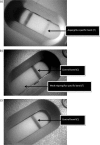Evaluation of real-time PCR, galactomannan enzyme-linked immunosorbent assay (ELISA), and a novel lateral-flow device for diagnosis of invasive aspergillosis
- PMID: 23486712
- PMCID: PMC3647888
- DOI: 10.1128/JCM.03189-12
Evaluation of real-time PCR, galactomannan enzyme-linked immunosorbent assay (ELISA), and a novel lateral-flow device for diagnosis of invasive aspergillosis
Abstract
Diagnosis of invasive aspergillosis (IA) remains challenging. With a relatively low incidence of disease, the use of expensive empirical antifungal therapy exposes many patients to unnecessary toxicity. Diagnosis places emphasis on specific but temporal radiological evidence. Circulating biomarker diagnosis has shown potential, but assays show variable performance, take several hours to perform, and require a degree of technical ability. A novel and simple lateral-flow device (LFD) using monoclonal antibody JF5, which targets an extracellular glycoprotein, has been developed and potentially removes any technical requirements, reducing processing time considerably. In this study, we evaluate the performance of this LFD compared to real-time PCR (targeting the 28S rRNA gene) and galactomannan (GM) detection when testing serum from a European Organization for Research and Treatment of Cancer/Invasive Fungal Infections Cooperative Group, National Institute of Allergy and Infectious Diseases Mycoses Study Group (EORTC/MSG)-defined hematological population. In a proven/probable-IA population versus a no-IA population, the LFD performance was comparable to that of both PCR and galactomannan enzyme immunoassay. Specificity (98.0%) was similar to that of PCR (96.6%) and slightly superior to that of GM (91.5%). Sensitivity (81.8%) was inferior to that of PCR (95.5%) but better than that of GM (77.3%). In combination with PCR, it provided both 100% sensitivity and 100% specificity. The LFD permits rapid testing of easily obtainable specimens, to be used as an adjunct test, before confirmation by other investigations. Its simplicity provides centers without specialist diagnostics with a test with clinical performance superior to that of classical microbiological approaches and results that can be used to direct antifungal management. In summary, microbiological diagnosis of IA is difficult and options are limited, with variable performance. An LFD assay targeting a novel specific biomarker has been developed, one which is methodologically simple and provides good clinical performance, particularly if combined with PCR.
Figures
References
-
- De Pauw B, Walsh TJ, Donnelly JP, Stevens DA, Edwards JE, Calandra T, Pappas PG, Maertens J, Lortholary O, Kauffman CA, Denning DW, Patterson TF, Maschmeyer G, Bille J, Dismukes WE, Herbrecht R, Hope WW, Kibbler CC, Kullberg BJ, Marr KA, Muñoz P, Odds FC, Perfect JR, Restrepo A, Ruhnke M, Segal BH, Sobel JD, Sorrell TC, Viscoli C, Wingard JR, Zaoutis T, Bennett JE, European Organization for Research and Treatment of Cancer/Invasive Fungal Infections Cooperative Group, National Institute of Allergy and Infectious Diseases Mycoses Study Group (EORTC/MSG) Consensus Group 2008. Revised definitions of invasive fungal disease from the European Organization for Research and Treatment of Cancer/Invasive Fungal Infections Cooperative Group and the National Institute of Allergy and Infectious Diseases Mycoses Study Group (EORTC/MSG) Consensus Group. Clin. Infect. Dis. 46:1813–1821 - PMC - PubMed
-
- Karageorgopoulos DE, Vouloumanou EK, Ntziora F, Michalopoulos A, Rafailidis PI, Falagas ME. 2011. β-d-Glucan assay for the diagnosis of invasive fungal infections: a meta-analysis. Clin. Infect. Dis. 52:750–770 - PubMed
-
- Leeflang MM, Debets-Ossenkopp YJ, Visser CE, Scholten RJ, Hooft L, Bijlmer HA, Reitsma JB, Bossuyt PM, Vandenbroucke-Grauls CM. 2008. Galactomannan detection for invasive aspergillosis in immunocompromised patients. Cochrane Database Syst. Rev. 8(4):CD007394 doi:10.1002/14651858.CD007394 - DOI - PubMed
-
- Maertens J, Theunissen K, Lagrou K. 2010. Galactomannan testing, p 105–124 In Pasqualotto AC. (ed), Aspergillosis: from diagnosis to prevention, 1st ed Springer Publishers, London, United Kingdom
-
- Mengoli C, Cruciani M, Barnes RA, Loeffler J, Donnelly JP. 2009. Use of PCR for diagnosis of invasive aspergillosis: systematic review and meta-analysis. Lancet Infect. Dis. 9:89–96 - PubMed
Publication types
MeSH terms
Substances
LinkOut - more resources
Full Text Sources
Other Literature Sources


